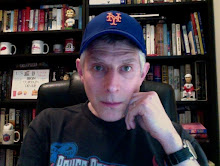 |
| The team from The Launching Pad |
It wasn't the first time relocation had rejuvenated the peripatetic Braves, one of the N.L.'s founding franchises.
Sixteen years earlier, as attendance tanked in Boston, the moribund 64-win team relocated to the good land, won 28 more games in their 1953 debut and then, four years later, a championship.
The 1969 edition won 93 games, finishing first in the newly-created NL Western Division. Their roster was studded with stars: future home run king Hank Aaron, his fellow future Hall of Famer Orlando Cepeda plus slugger Rico Carty and former New York Yankees' mainstay Clete Boyer. Leading their pitching staff was a 23-game winner, knuckleballer Phil Niekro.
Stoked to plant their pennant, they produced a gorgeous 80-page playoff program -- full of articles, photos, rosters and stats -- wrapped by a moon landing-themed cover that declared, "One step for the Braves. One giant leap for the Southeast."
 |
| The first ever NL West champions (from the Braves' 1969 NLCS program). |
But to reach their figurative moon, they needed to step past the New York Mets.
After languishing in last or next-to-last place for the first seven years of their existence and merely a .500 ball club as late as June 2, New York's NL franchise caught fire in the summer, overtaking the first place Chicago Cubs on Sept. 10 and then winning the Eastern Division by eight games. They finished at 100-62.
Leading their charge was brash power pitcher Tom Seaver, a 25-game winner who would have been Braves property had they not violated the rules for signing college players in 1966.
Three years after his Braves contract was voided, Seaver was not merely the best pitcher in baseball, but leading a staff that included 17-game-winner Jerry Koosman, rookie Gary Gentry and down the depth chart, a young fireballer named Nolan Ryan.
 |
| The Mets' NLCS program, an adaptive reuse of their regular season scorecard with minimal new content, offered for just a single home game for 25 cents. |
"Good pitching will always stop good hitting, and vice versa," baseball sage Casey Stengel reportedly once said. The best-of-five Mets/Braves NLCS was a vice versa kind of series, where good pitching largely took a back seat to good hitting and somehow, the Mets had more of that too.
On Oct. 4, the series opened in Atlanta, in a bullring of a ballpark that came to be known as The Launching Pad. Seaver vs. Niekro. They traded punches until the eight inning when, with the Braves nursing a 5-4 lead, the Mets' erupted for five runs, helped by a pair of Atlanta errors. Game 1 to the New Yorkers, 9-5.
Game 2 the next day saw the Mets jump out to a 8-0 lead en route to an 11-6 romp. The Braves headed to New York, their moon landing in jeopardy.
 |
| Foreshadowing from the Braves program |
With two on and no outs in third, Hodges pulled Gentry in favor of Ryan, who sandwiched an intentional walk around two strikeouts and ended the inning on Braves catcher Bob Didier's fly out.
Atlanta would never seriously threaten again, while the Mets got homers from Agee and infielders Ken Boswell and Wayne Garrett.
Ryan pitched seven innings, striking out seven while allowing two runs to earn the win, one of just two post-season victories in his 27 year Hall of Fame career. Aaron wouldn't appear in the playoffs again. He retired as a Milwaukee Brewer after the 1976 season with the most homers in major league history: 755.
On Oct. 6, 1969, the Mets captured the NL pennant before a raucous crowd at Shea Stadium in Queens. Ten days later, they'd stun the Baltimore Orioles and the world by taking the World Series 4 games to 1. The moon belonged to them.
-- Follow me on Twitter @paperboyarchive

Andy, how can I acquire the color photo of the 1969 Braves team photo taken in their ballpark with their home white pin stripe jerseys? I am trying to photo match my game worn Bob Didier 1969 home jersey. Perhaps he is wearing my set 2home gamer. Please advise. Richard-Chicago
ReplyDeleteRichard -- thanks for your note. My copy of that photo came from the Braves' 1969 NLCS program. I can try to scan it in for you at a higher DPI (this one is likely 600), but that's really all I can do.
Delete